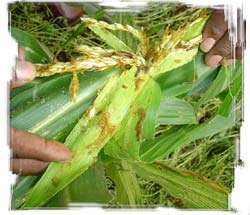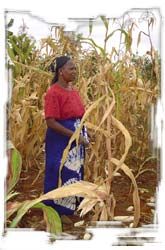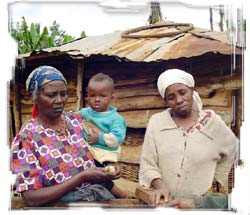CIMMYT E-News, vol 3 no. 7, July 2006
 Convincing risk-averse, resource-poor farmers to adopt a good technology is hard enough when they can see the enemy, but what if the enemy hides from view?
Convincing risk-averse, resource-poor farmers to adopt a good technology is hard enough when they can see the enemy, but what if the enemy hides from view?
Maize farmers in Africa struggle every day to protect their crop from pests. Some are obvious and relatively easy to control. After all, you can throw stones at a baboon that comes in for a meal and scarecrows and slingshots can stop birds.
One of the most damaging pests though does everything by stealth, virtually invisible to farmers. The moths that are parents to a class of pests called stem borers lay their eggs at night, on the underside of the emerging leaves of young maize plants. The caterpillars that hatch from the eggs soon make their way into the stalk itself, safe from all predators, including farmers.
“Many farmers in Kenya don’t even know their maize fields have a stem borer problem, yet these insects cost them some 400,000 tons in lost harvest each year,” says CIMMYT maize breeder Stephen Mugo.
He says the stealthy biology is one reason stem borers are sometimes thought to be less important than other quite visible maize pests like cutworms, armyworms, earworms and beetles. Storage pests like beetles and weevils, together with fungi are also rated high in importance, because their effects can be easily seen. “Farmers routinely attribute the damage to their crops to these pests, and not their ‘invisible’ enemy, the stem borer,” Says Mugo.

Chemical pesticides could control the two main species of stem borer found in eastern and southern Africa, says entomologist Dr. Macharia Gethi, the Director of the Embu Center of the Kenya Agricultural Research Institute (KARI). “Eggs are laid soon after the maize seedling emerges, around a fortnight after planting, and this is when stem borer control should be applied.” But this rarely happens. “Even farmers who know about stem borers only notice the damage after it’s too late for chemical control. A seed-based technology is what we need,” says Mugo.
In Muconoke village of Embu, located in the dry mid-altitude zone of eastern Kenya, farmers do know about borers and try to fight back. Elizabeth Njura has to apportion her meager budget to buy maize seed, fertilizer, and insecticide. She explains, “If I want a good maize harvest I have no choice but to buy all three.” Smallholder farmers like Njura have little cash for the inputs they need and lack reliable information about pesticide usage. As a result, the hidden borers happily grow in the maize stalk, starving the growing plant of nutrients. Mary Ngare says she is also disappointed with her maize harvest, even though she used the only pesticide she had to try to stop the borers. Unfortunately, what she had was intended for seed treatment and even then she applied it too late. The borers had already penetrated into her maize stalks.
Mugo is convinced that by embedding resistance technology into the maize seed itself, either by conventional breeding or biotechnology, farmers will have access to varieties that show far less borer damage.

With funding from the Syngenta Foundation for Sustainable Agriculture and the Rockefeller Foundation, CIMMYT is collaborating with the Kenya Agricultural Research Institute (KARI) to develop maize varieties that are resistant to the two most important stem borers in Kenya, Chilo partellus and Busseola fusca, using both conventional breeding and biotechnology. The work, coordinated by Mugo, is part of the Insect Resistant Maize for Africa (IRMA) project.
“Maize that resists stem borer damage would take the guesswork out of stem borer pesticide usage by eliminating it altogether,” says Mugo. He is excited that six of IRMA’s conventionally bred varieties are now in the national variety performance trials in Kenya, and is hopeful that some of these will reach smallholder farmers in the near future.
For more information contact Stephen Mugo (s.mugo@cgiar.org)